The year 1939 marked the completion of 50 years since the Ahmadiyya Muslim Jamaat’s establishment and 25 years of the second Khilafat. The Ahmadiyya Jamaat was fully engaged in preparations to celebrate the occasion of Khilafat Jubilee.
During the proceedings of Majlis-e-Shura of that year, a subcommittee for jubilee programmes presented a number of proposals regarding the inauguration of the jubilee. One such suggestion was that a standard flag of the Ahmadiyya Jamaat should be created and a request be presented before Hazrat Khalifatul Masih IIra to formally hoist that flag on the occasion of the Jubilee Jalsa.
Members of the Shura presented their proposals regarding this particular suggestion. Certain members were of the view that flags are associated with temporal states, therefore there was no need for it at the time. Thereupon, Hazrat Musleh-e-Maudra asked the scholars of the community to voice their opinions on the matter.
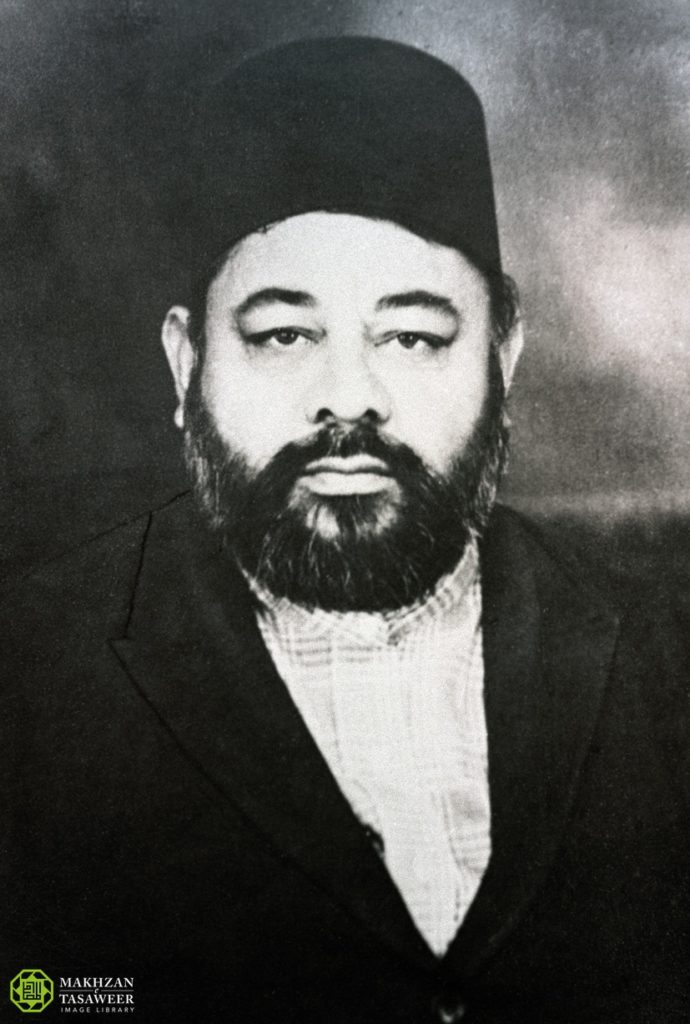
Hazrat Mir Muhammad Ishaqra expressed that once, when the Holy Prophetsa went to offer the Eid prayer in Medina, a flag was hoisted in the Eid Gah. Likewise, a flag was hoisted on the occasion of Hajja-tul-Wida.
Hazrat Maulvi Syed Muhammad Sarwar Shahra stated that the Promised Messiah, Hazrat Mirza Ghulam Ahmadas witnessed in a vision that he possessed a flag.
After the opinions of members and scholars, Hazrat Khalifatul Masih IIra put the matter to vote. A total of 376 members voted in favour of this suggestion. Deciding the matter in favour of the majority of the votes, the Second Khalifara approved the proposal of creating a new flag.
Thereafter, members of the Shura gave their opinions on the second part of the suggestion, i.e. regarding the hoisting of the flag. After hearing the opinions of the members, Hazrat Khalifatul Masih IIra stated, “I decide in favour of the majority of the opinions that the flag should be hoisted.”
Hazrat Musleh-e-Maudra laid down fundamental instructions regarding the preparations of the flag. Huzoorra said:
“I am of the opinion that a specific amount in paisas (one hundredth of a rupee) or even less, should be collected from particular Companionsra of the Promised Messiahas and cotton should be bought from the sum of money, which should be handed over to the female Companionsra for spinning and eventually to those companionsaa who are tailors to prepare cloth from the yarn. Similarly, the Companionsra should cut and clip suitable wood [for the mast] which should then be handed over to representatives of the Jamaat after being wrapped and this should be our first official flag. Thenceforth, it should be copied and reproduced. In this way, the values of the Jamaat shall be associated with it in a manner that the generations to come will surely be ready to present any kind of sacrifice for it.”
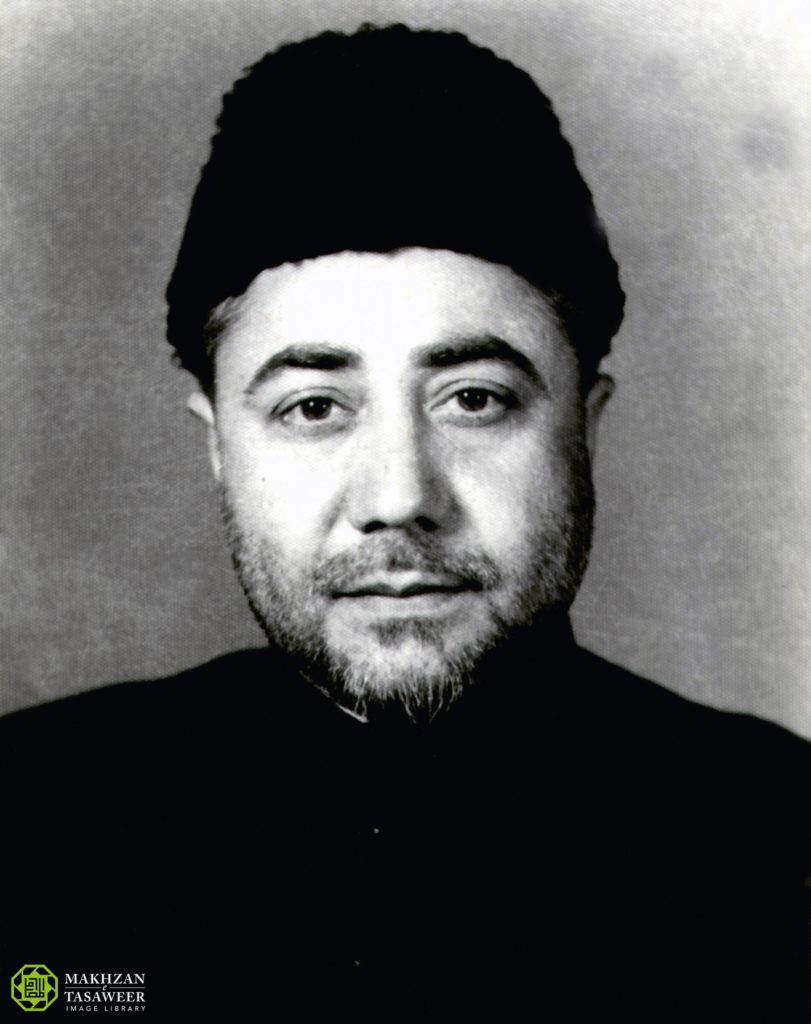
Hazrat Musleh-e-Maudra formed a committee for Liwa-e-Ahmadiyyat, which included Hazrat Sahibzada Mirza Bashir Ahmad MAra, Hazrat Syed Mir Muhammad Ishaqra and Hazrat Sahibzada Mirza Nasir Ahmadrh as its members.

This committee was responsible for carrying out each task regarding the preparation of the flag, i.e. determination of its design, collection of Chanda from male and female Companionsra of the Promised Messiahas, preparation of fabric, decision regarding its length and breadth, arrangement of a pole and various other plans related to the installation and hoisting of the flag. Though every task was new for members of the committee, they prepared a report after deep consideration and presented it before Hazrat Musleh-e-Maudra. Huzoorra viewed various sketches of Liwa-e-Ahmadiyyat. Eventually, Huzoorra granted the approval of the design which currently exists in the Jamaat.
The details of the first Liwa-eAhmadiyyat’s preparations are not only interesting but spiritually uplifting as well.
Initially, the work began with the collection of Chanda, which, in accordance with the desire of Hazrat Khalifatul Masih IIra, was to be collected from the Companionsra of the Promised Messiahas. So, an appeal was presented before the Companionsra, which primarily resulted in the collection of only 23 rupees, 8 annas and 3 paisas. The reason behind the collection of this significantly smaller amount was that certain Companionsra perceived by mistake that contributions of more than one paisa in Chanda were not being accepted. Hence, a more powerful appeal was made for a second time, which led to the collection of 130 rupees and with that, resulted in the successful completion of this stage.
After the collection of monetary funds, the second stage was to arrange for cotton. Regarding the purchase of cotton, Hazrat Musleh-e-Maudra was of the view that it would be ideal if such cotton became available which had been grown by the Companionsra. A companion by the name of Hazrat Mian Faqih Muhammadra, Amir Jamaat-e-Ahmadiyya Winjwan, District Gurdaspur, went to Qadian, presented some yarn before Hazrat Amma Janra and expressed that following the instructions of Sahibzada Mirza Bashir Ahmad Sahibra, he himself had sown its seed and continued to water it. Then, having picked the cotton, he got it combed from the Companionsra and managed to have it spun in his house.
Receiving the yarn, Maulana Abdul Rahim Dard Sahib, Secretary Khilafat Jubilee Committee sent a message to Amir Jamaat-e-Ahmadiyya Winjwan that he should present some more cotton if he had any from that which he himself cultivated. Amir Jamaat-e-Ahmadiyya Winjwan sent 8 to 10 seer [one seer equals approximately 2 pounds] of cotton to Qadian through another companion of the Promised Messiahas, Hazrat Bhai Abdul Rahmanra. Thereafter, Hazrat Umme Tahirra, General Secretary Lajna Imaillah had this cotton spun into a yarn from female Companionsra.
Now came the stage of preparing fabric from the yarn. Hazrat Sahibzada Mirza Nasir Ahmadrh got the yarn weaved into fabric from certain Companionsra of Qadian and Talwandi who knew the art of weaving. One such companion was Hazrat Mian Khairuddinra.
According to the decision of the committee, Liwa-e-Ahmadiyyat was likely to be 18 feet long and 9 feet wide. Hence, there came the need of those Companionsra who were skilled tailors. They too became easily available by the grace of God and the woven fabric was prepared in its required size through their help and efforts.
Thereafter, the required prints were to be drawn on the flag. Hence, this task was accomplished by the joint efforts of Malik Ataur Rahman Sahib and Hazrat Sahibzada Mirza Nasir Ahmadrh from Shahdara, District Lahore.
The availability of 62-foot straight, long and fine wood was an issue of great significance, which in fact seemed impossible. It was decided after deep consideration to make do with a metal pipe. Hence, an iron pole was made available through the efforts of Babu Akbar Ali Sahib.
Below are the features of Liwa-e-Ahmadiyyat, which was created after the final approval of Hazrat Musleh-e-Maudra:
– The flag was 18 feet long and 9 feet wide
– The colour was black
– A full moon was printed on one side while a crescent was etched on the other
– Minarat-ul-Masih was imprinted near the full moon
– The verse of the Holy Quran:
وَ لَقَدۡ نَصَرَکُمُ اللہُ بِبَدۡرٍ وَّ اَنۡتُمۡ اَذِلَّۃٌ
ٌ“And Allah had already helped you at Badr when you were weak” (Surah AleImran, Ch.3: V.124), was written above the full moon
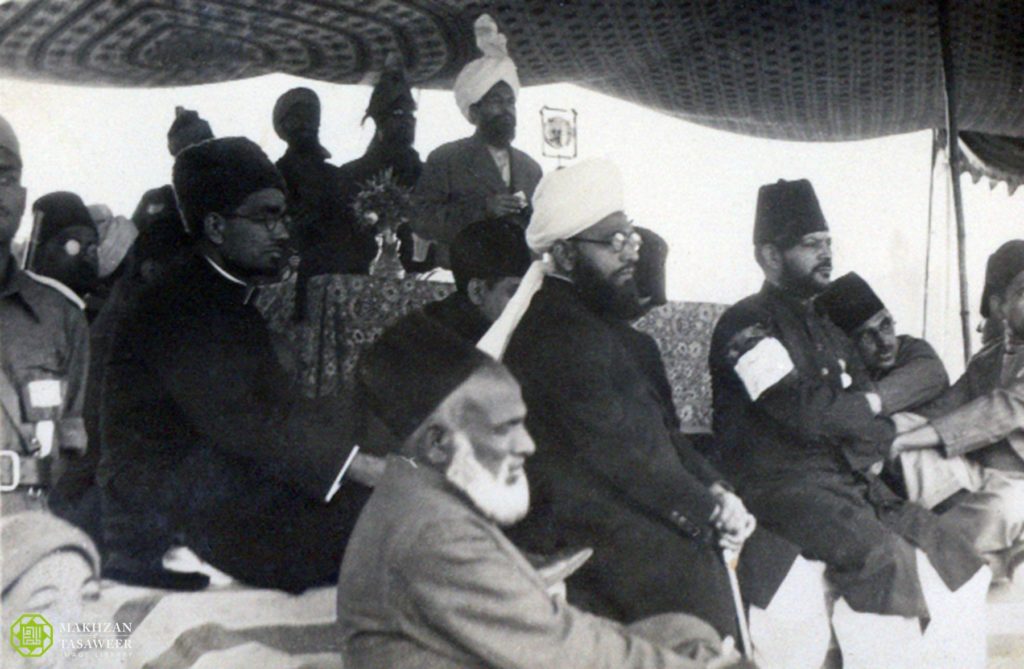
The programme of the blessed event of Khilafat Jubilee began on the morning of 28 December 1939. Two speeches of Hazrat Khalifatul Masih IIra were held on the same day. In his last address, Huzoorra highlighted the background behind the creation of Liwa-e-Ahmadiyyat and said:
“People question erecting flags as if it is an innovative mere ritual. The reality is that it is not an innovation. The Holy Prophetsa himself raised a flag and stated that he would hand it over to that person who could fulfill its responsibility. Hence, considering it an innovation indicates lack of awareness of Islamic history. Hoisting flags is not forbidden. I, myself, have heard the Promised Messiahas say in a gathering that we ought to possess a flag. A flag is the symbolic representation of the gathering of people and it is a source of imparting enthusiasm in the youngsters. The Promised Messiahas said:
لوائے ماپنہ ہر سعید خواہد بود
‘The refuge of my flag will be acquired by every blessed person’, and it is required from this perspective that we set up our flag so that the fortunate souls seek refuge under it. These apparent signs hold great significance. Thus, it is very necessary to have a flag and instead of it being created through the hands of a king, it is far better that it is created through the hands of the Promised Messiah’sas Companionsra and in the time of the Promised Khilafat. We are grateful to God Almighty that he granted us the strength to create that flag through which a couplet of the Promised Messiahas is apparently fulfilled as well. I have prepared a pledge as well so as to enable us to bear in mind the spiritual side and so that this does not become a mere apparent tradition.”
A 5-foot high platform was built towards the north-western side of the stage. Hazrat Khalifatul Masih IIra came down from the stage, reaching this platform at 2:04pm and said that every person should constantly pray in the words:
رَبَّنَا تَقَبَّلۡ مِنَّا ؕ اِنَّکَ اَنۡتَ السَّمِیۡعُ الۡعَلِیۡمُ
“Our Lord, accept this from us; for Thou art the All Hearing, the All Knowing” (Surah al-Baqarah, Ch.2: V.128).
Huzoorra himself expressed the words of the same prayer in a very emotional and loud voice. After the unfolding of the flag, Huzoorra untied the string and as the flag rose and reached the top, slogans of Allahu Akbar were raised. There was no wind at the time of flag hoisting and it rose towards the top in a manner that its design was not visible, but as soon as it reached the top, a sudden gust of wind caused the entire flag to flutter and reveal itself to those present. The whole gathering had a clear look at it as the wind settled down again. After the completion of this ceremony, Huzoorra came on stage and took a pledge from the Jamaat:
“I bear witness that I will always continue to strive for the establishment, solidarity and promulgation of Islam and Ahmadiyyat to the best of my ability and understanding. I will present every possible sacrifice through the help of God so that Ahmadiyyat, the [true] Islam, prevails over every other religion and its flag never falls, and, in fact, continues to wave higher than every other flag. O Allah, fulfil my prayer; O Allah, fulfil my prayer; O Allah, fulfil my prayer!
رَبَّنَا تَقَبَّلۡ مِنَّا ؕ اِنَّکَ اَنۡتَ السَّمِیۡعُ الۡعَلِیۡمُ
[‘Our Lord, accept this from us; for Thou art the All Hearing, the All Knowing.’ (Surah al-Baqarah, Ch.2: V.128)]
Huzoorra issued special instructions regarding the safety of Liwa-e-Ahmadiyyat and said, “Khuddam-ul-Ahmadiyya should appoint 12 men to safeguard this flag at the moment and it should be handed over to 2 nazirs after the Friday prayer who should be responsible for its safety. They should place it behind a firm lock, having two keys, which are both needed to access it.”

A committee was established under the guidance of Hazrat Khalifatul Masih Vaa in 2006 to save Liwa-e-Ahmadiyyat from the eff ects of weather and natural decay. This committee is responsible for taking practical steps for the preservation of Liwa-e-Ahmadiyyat, after taking recommendations from technical experts. The committee was told by certain experts that it would be better to roll Liwa-e-Ahmadiyyat instead of folding it.
The task of preserving Liwa-e-Ahmadiyyat began in the lawn of Sadr Anjuman Ahmadiyya, situated in front of the committee room, at 5 o’clock in the evening of 12 June 2006. Six members of Sadr Anjuman Ahmadiyya were present on this occasion, namely Mirza Khurshid Ahmad Sahib, Mirza Ghulam Ahmad Sahib, Malik Khalid Masood Ahmad Sahib, Syed Abdul Haye Shah Sahib, Salimuddin Sahib and Syed Tahir Ahmad Sahib. Representing Khuddam-ulAhmadiyya were the naib sadr, motamid and ten central office-bearers. Moreover, Wasim Ahmad Sahib, a curator of Lahore Museum, Mubashir Ahmad Dehlvi Sahib, staff members of MTA and various staff members of Sadr Anjuman Ahmadiyya were also present.
At around 5:30pm, the trunk of Liwae-Ahmadiyyat was brought from the office of Sadr Anjuman Ahmadiyya and it was spread on a platform of tables aft er being carried out from the trunk. During the process, measurements of the flag and the prints were taken along with some photographs.
Thereafter, the official commencement of the event began with the recitation of the Holy Quran, which was presented by Hafiz Khalid Iftikhar Sahib, Mohtamim Atfal, followed by a brief history of Liwae-Ahmadiyyat from Tarikh-e-Ahmadiyyat by the Motamid of Majlis Khuddam-ul-Ahmadiyya Pakistan. Then, the nazir-e-ala and amir-e-muqami led everyone in silent prayer.
After the prayer, Liwa-e-Ahmadiyyat was wrapped around a 4-inch UPVC pipe, which was already covered with pure cotton paper with help of a cotton thread. Once, Liwa-e-Ahmadiyyat was carefully rolled, it was again covered with pure cotton paper. It was then placed and secured in a 12-inch UPVC pipe.
According to the recommendation of Wasim Ahmad Sahib, two chemicals – thymol for the removal of insects and silica gel, which controls humidity present in the air – were placed inside the pipe, wrapped in a very fine cotton fabric.
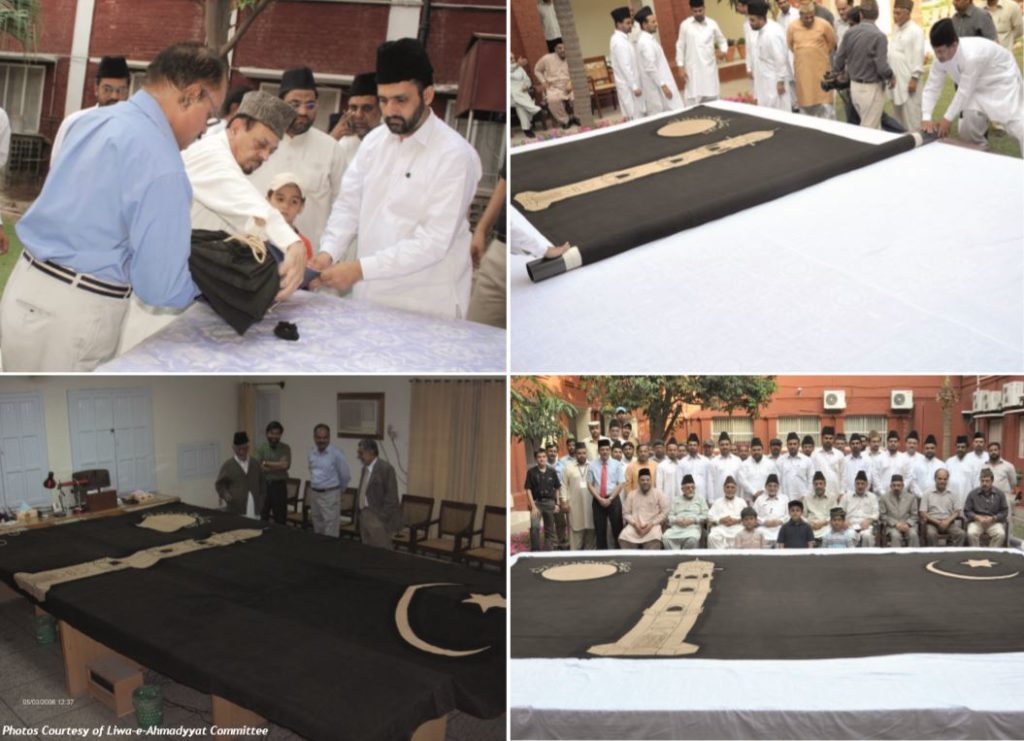
Under the instructions of Hazrat Mirza Masroor Ahmad, Khalifatul Masih Vaa, Liwa-e-Ahmadiyyat is brought out of its secure case and thoroughly examined for preservation purposes every few years. It is professionally preserved, rolled and placed back in its secure case. The recent preservation took place on 1 May 2019 according to the instructions of Hazrat Khalifatul Masih Vaa.
Let us repeat the same pledge again for the exaltation and the safeguard of Liwa-e-Ahmadiyyat, which has been committed to our trust:
“I bear witness that I will always continue to strive for the establishment, solidarity and promulgation of Islam and Ahmadiyyat to the best of my ability and understanding. I will present every possible sacrifice through the help of God so that Ahmadiyyat, the [true] Islam, prevails over every other religion and its flag never falls, and, in fact, continues to wave higher than every other flag. O Allah, fulfil my prayer; O Allah, fulfil my prayer; O Allah, fulfil my prayer!
رَبَّنَا تَقَبَّلۡ مِنَّا ؕ اِنَّکَ اَنۡتَ السَّمِیۡعُ الۡعَلِیۡمُ
[‘Our Lord, accept this from us; for Th ou art the All Hearing, the All Knowing.’]
A complete record of the movement of Liwa-e-Ahmadiyyat has been documented in a log book, however, this record only dates back to the first Jalsa Salana that took place after the partition of India and Pakistan. Under the instructions of Hazrat Khalifatul Masihaa, the Liwa-e-Ahmadiyyat Hifazat [Protection] Committee is in charge of its preservation and protection.
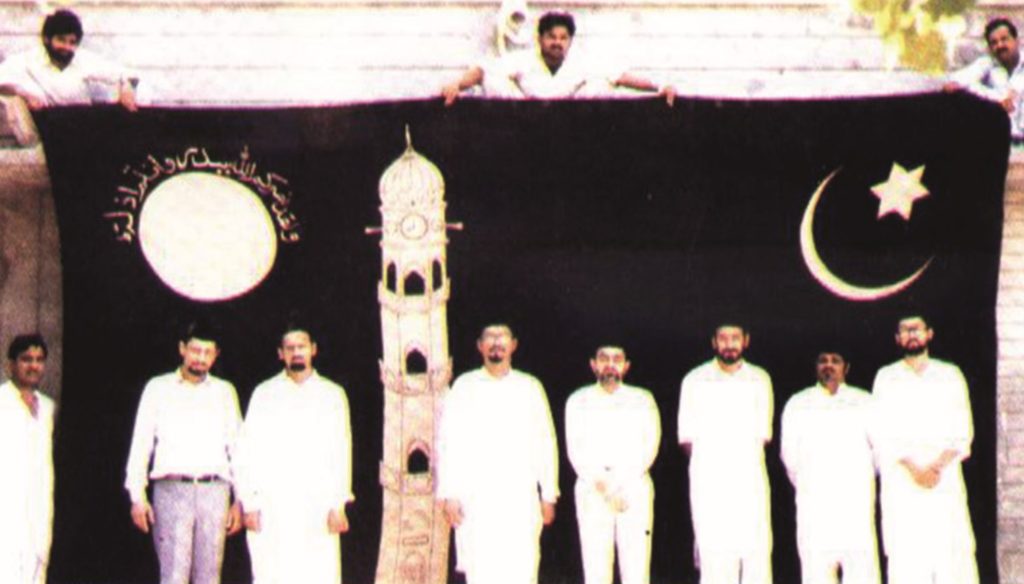
Before Khilafat, Hazrat Mirza Masroor Ahmadaa was also among those who were present at the viewings of the flag. A photograph from 1986 shows Hazrat Khalifatul Masih Vaa standing by the Liwa-e-Ahmadiyyat.
In a video recording of the 1988 preservation event, Huzooraa is seen holding the flag; the flag that he would soon be the greatest defender of as Khalifatul Masih.
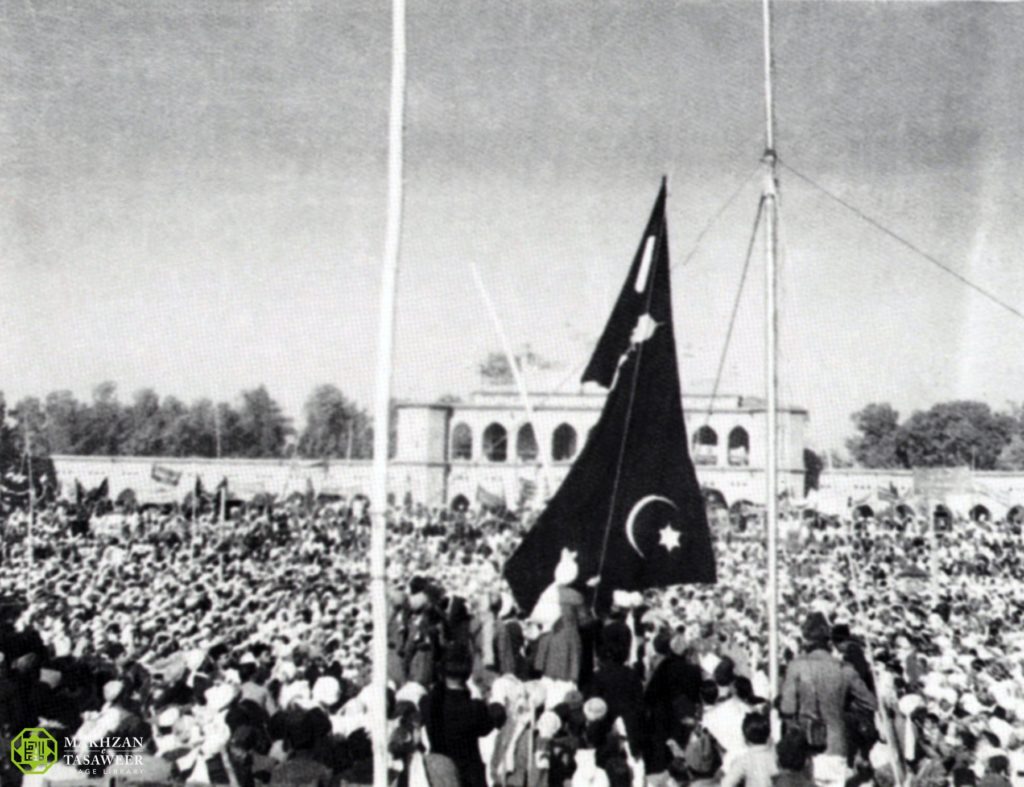



اے لوائے ء احمدیت قوم احمد کے نشان
تجھ پہ کٹ مرنے کو ہیں تیار تیرے پاسبان
Thank you for this history sharing article. I just found out more about one of my ancestors.